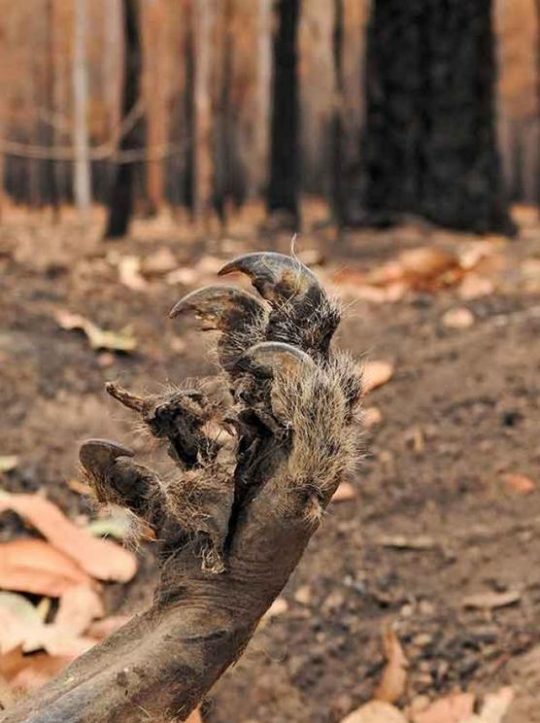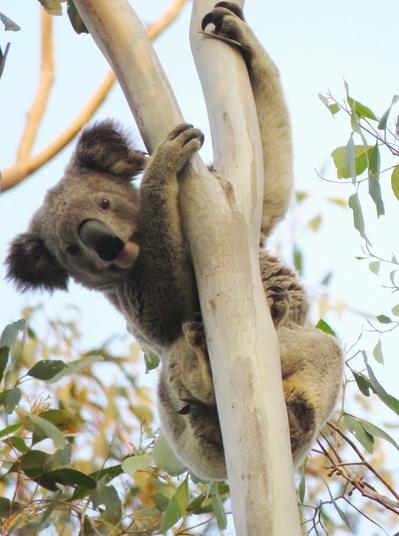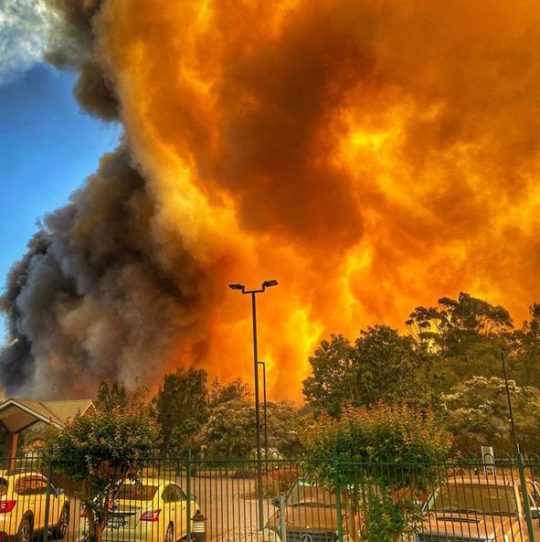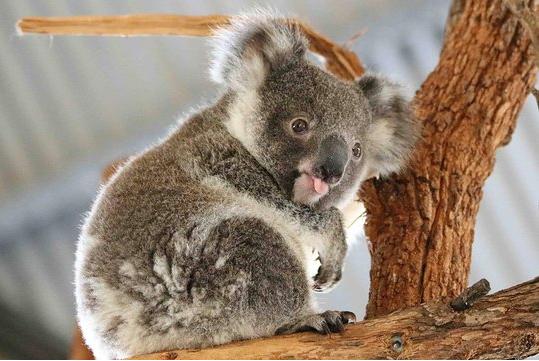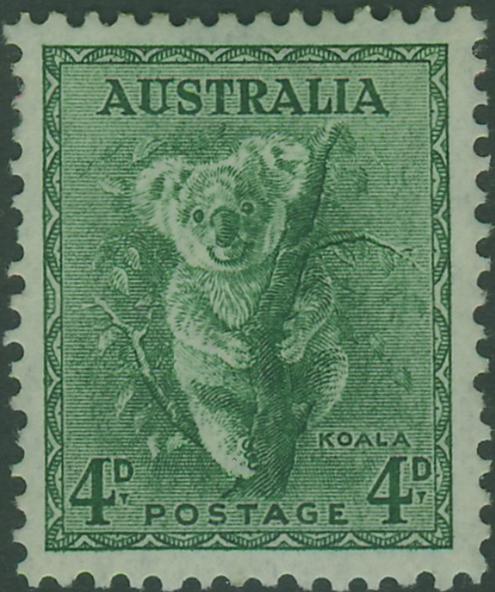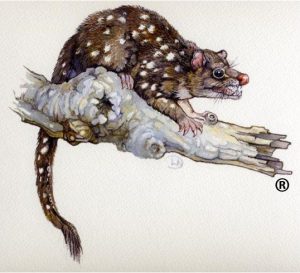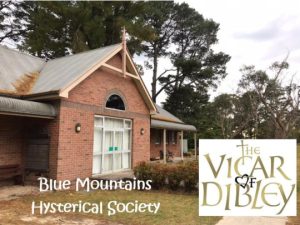Government sanctioned wildlife mass extinction
Right now, Australia is being ravaged by one of the most devastating bushfire programmes the country has ever seen.
So far, more than 10 million hectares of Australian land has been burned to the ground. At least one billion native animals have lost their lives so far, including thousands of koalas, kangaroos, wallabies, birds and other iconic wildlife. Koalas were already on the brink extinction as local governments have approved deforestation of their shrinking native habitat to facilitate housing development. It’s otherwise a culture of anthropocentric greed.
This casualty estimate does not include farm animals, otherwise statistically listed as ‘livestock’. ‘Pets’ neither feature as an identifiable statistic by the authorities. Just humans, whose funerals the Prime Minister and relevant Premier attend for relevant PR.
It’s estimated that as many as 8,400 koalas have perished in fires (read “burned to death”) on the mid-north coast of NSW and Kangaroo Island in South Australia has lost over 50% of their koala population (so far). This is a devastating regional extinction event for an unique iconic species already in serious decline.
But that is where we end the WWF quote, because as eternal optimists they go on to suggest a “wildlife response”, “habitat restoration” and “future proofing Australia”. This is a naive false hope.
It’s too bloody late you environmentalist hypocrites, distracted by notional climate theories while conspicuously silent on palpable government forest arson.
The above photo is of a large male koala found incinerated alive by the bushfire at Braemer State Forest at Rappville (NSW Northern Rivers Region) [Source: ‘Koala killed in fire at Braemer State Forest at Rappville’, 30th October 2019, ABC Media, Copyright Hugh Nicholson, ^https://www.abc.net.au/news/2019-10-30/koala-killed-in-fire-at-braemer-state-forest-at-rappville-1/11655898]
Likely Before Photo:
Likely During Photo:
Real After Photo:
The Braemar State Forest is a 2000-hectare forest straddling the Summerland Way about 25 km south of the town of Casino in northern New South Wales. On 28th April 2008, the New South Wales government gazetted that appropriately licensed people could hunt game and feral animals in Braemar State Forest. Habitat custodians? There is a second Braemar State Forest 30km west of the town of Dalby in Queensland which is west of Toowoomba and Brisbane.
So much for the empty promise of national parks. There were never national, not nationally managed, but delegated to state and territory governments with no custodial interest, little federal funding and conflicting priorities like accommodating the incessant human plague.
Koalas will now be extinct in the wild in many forested regions of eastern Australia due to the combination of human hate toward them- ongoing excessive deforestation for agricultural and urban development, government sanctioned logging, new resident dog attacks, and state arson or abandoned bushfires.
The 2019 Summer Extinction Watershed
Before the summer of 2019 Eastern Australia had remnant native forests, a few of World Heritage listing protection no less to sustain ecological habitats for precious wildlife.
Then 10 million hectares of these forests, most of Australia’s remnant forest ecology, was incinerated in a mass government sanctioned multi-species extinction programmed event.
Post Summer 2019, Eastern Australia’s forests are dead silent parks made more conducive to anthropocentric use.
Quite simply, original ecological Australia has gone – no ifs or buts, no glass half full restoration PR.
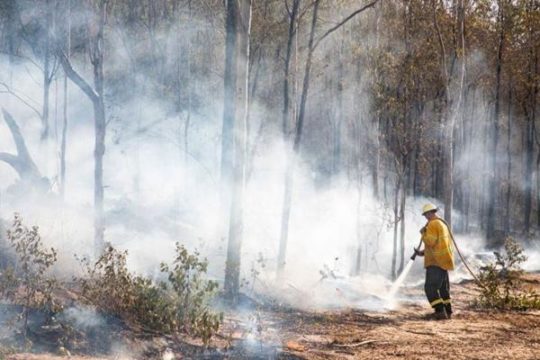 Government rural fire lighting service: “Big time hazard reduction job done, about time.”
Government rural fire lighting service: “Big time hazard reduction job done, about time.”
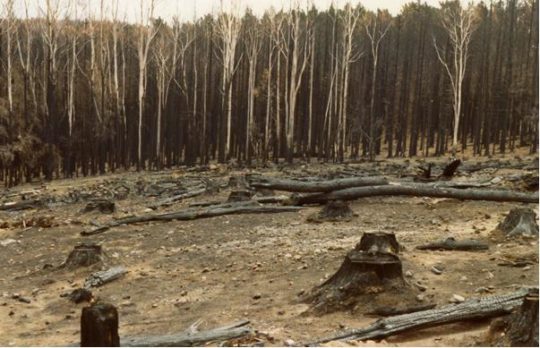 CFA: “That’s more like it! Burn it before it burns.”
CFA: “That’s more like it! Burn it before it burns.”
Australia’s wildfires have now burned more than 6 million hectares across the continent, leaving an estimated 1.25 billion animals dead, according to the World Wildlife Fund, which arrived at this figure based on University of Sydney Professor Chris Dickman’s work.
Organizations like Zoos Victoria have found themselves pressed into de facto emergency relief agencies on the front lines of saving impacted animals. Two Zoos Victoria veterinary staff members were recently given permission to go into fire zones in order to treat koalas and other wildlife.
“We’re all devastated. Devastated, but in the really fortunate position that we’ve got the kind of skilled staff that can go into the field and really make a difference,” said Michelle Lang, general manager at Zoos Victoria, which operates three zoos in the state, as well as a host of other conservation programs.
“Despite their injuries and trauma, the bravery shown by the koalas and wildlife at Mallacoota is inspiring,” Dr. Leanne Wicker, who went into the bush, said in a press release.
According to Lang, Zoos Victoria was “pretty well prepared” to engage in their response role, considering the sheer scale of the fires, because of previous programs they have implemented, such as their Marine Response Unit, which was created 2013 responds to calls for assistance with vulnerable animals on a daily basis. Lang pointed out that many of the most decimated wildlife populations will be, “small, unknown, unglamorous animals that are so vital to our ecosystem and our chain of biodiversity.
“Some species, there were only 2,000 of them before the fires, so we hate of think how many of them will be left after this,” she said. In addition to the iconic koala bears, other impacted animals across the continent include the nabarlek, bilby, northern bettong, gouldian finch, numbat, and wiliji.
Dr. Stuart Blanch, Senior Manager of Land Clearing and Restoration at WWF-Australia, identified the long-footed potoroo, mountain pygmy possum, yellow-bellied glider and brush-tailed rock wallaby, as well as the regent honeyeater and glossy black cockatoo, which are both critically endangered, as being particularly at-risk, due to the destruction of their habitats.
Blanch told the media earlier this week that, “Up to 30% of koalas (as many as 8,400 koalas) may have perished during fires on the mid-north coast of New South Wales. This is a devastating blow for a species already in decline, due to ongoing excessive tree-clearing for agricultural and urban development, and pushes the species closer to becoming an endangered species.
“This has the potential to hasten koalas’ slide towards extinction in the wild in eastern Australia,” he said.
Contextualizing the impact of these fires, WWF-Australia CEO Dermot O’Gorman said many of the country’s forests and animals are facing a decades-long recovery, if the latter are able to bounce back at all.
“… some species may have tipped over the brink of extinction,” O’Gorman said in a written statement.
Zoos Victoria, which launched a $30 million initiative to save 20 species from extinction in 2015, has since grown that number to 27. They also operate conservation programs in six countries and can point to several successes such as their breeding of the critically endangered Baw Baw frog last year, and releasing dozens of critically endangered orange-bellied parrots into the wild. On the strength of this experience, they are anticipating which steps will be required after the fires die down. Lang said that potential scenarios include supplementary feeding programs for animals that survive, but are faced with a lack of food, animals that need to be protected from an over-population of predators, new holding areas, specific food items, habitat restoration, and extra staff.
Though Zoos Victoria is currently responding to alleviate the suffering of animals, and planning for possible eventualities, the full scope of the damage at the moment, to say nothing of what the reality will be after the fires die down, is unknown.
“We don’t actually know what we’re dealing with,” Lang said.
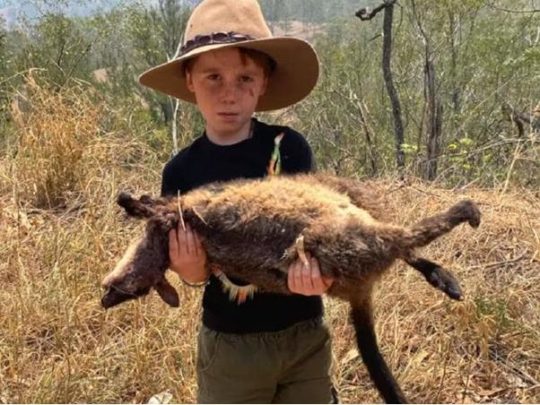 Brush-tailed Rock Wallaby incinerated in ‘protected’ Barrington Tops National Park.
Brush-tailed Rock Wallaby incinerated in ‘protected’ Barrington Tops National Park.
“Dad, everything is dying.” – the heartbreaking words from Matthew Faulkner, 7, as he cradled a dead wallaby whose habitat had been incinerated by bushfires.
Matthew’s dad, is Tim Faulkner, who is president of NSW animal protection organisation Aussie Ark. The organisation started in 2011 with a focus on saving the Tasmanian devil from extinction and has since expanded. Aussie Ark has been setting food and camera traps to feed the animals amid Australia’s devastating bushfire crisis.
“Australia is in crisis,” Tim Faulkner says. “It has the WORST mammal extinction rate of any country in the world. Home to more than one million species of plants and animals, Australia’s wildlife is uniquely ours, found nowhere else in the world. Prior to the current fires, over 90 per cent of koala habitat had already been lost with the remaining 10 per cent being fragmented and vulnerable to intense bushfire.”
Native forests of Eastern Australia are no longer. They are mystical history now. All hope is indeed lost. Wildlife species across vast swathes of forest landscape are not Buddhists and cannot be reincarnated. It may shock many in the conservation movement, who are already in shock, that this has been a mass extinction event, and worse that it has been deliberate defacto hazard reduction on a nationwide (continental) scale across what was remnant forested New South Wales, Victoria, South Australia, and Queensland (not so long a go).
It is a sociopathic culture of Baby Boomer native forest hate. It is akin to colonial Australia, when Aborigines were treated as savages and so massacred in a co-ordinated government-sanctioned hunting parties, and when native animals were treated as vermin.
Little has changed since 1788. British colonial aspirations have culturally prevailed in Australia down the generations. The British 19th Century romantic notion of taming the wild (landscape, natives and wildlife) have culturally prevailed indeed in government policy in appropriately named ‘New South Wales’ and ‘Victoria’.
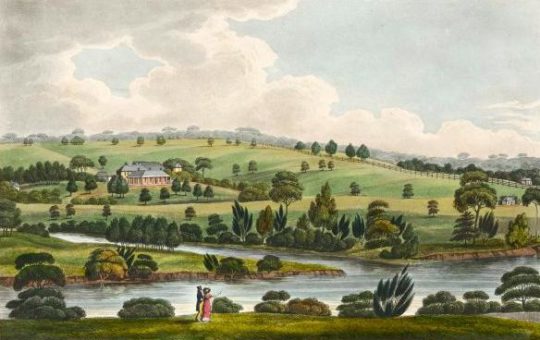 Joseph Lycett’s pastoral landscape interpretation of early colonial Australia.
Joseph Lycett’s pastoral landscape interpretation of early colonial Australia.
[Joseph Lycett, b.1774-1828, a convict and artist, born in Staffordshire, England]
Post-colonial Australia is getting there – a tamed British landscape to suit.
In Victoria, the state government from 1st October 2019 authorised mass slaughter of native kangaroo species because graziers on deforested rural landholdings were having problems competing or grass and water with desperate kangaroos during this current drought cycle. The only thing that has changed since colonial times is that the government euphemistically brands the mass slaughter as a Kangaroo Harvesting Programme and the gives it an even more euphemistic acronym, ‘KHP’.
“So whata ya up to today mack? Oh, I’m going out to do a bit of KHP with me pig dogs.”
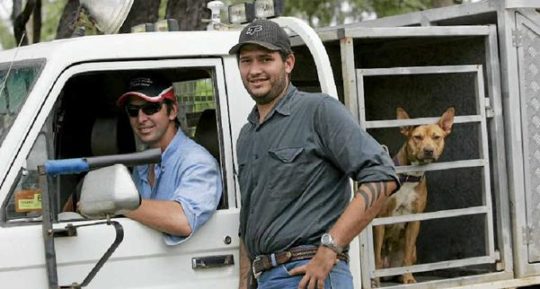 British cultural feral fox hunting persists generations on, downunder
British cultural feral fox hunting persists generations on, downunder
Further Reading:
[1] ‘Our Aussie icons are losing their homes & their lives to catastrophic bushfires‘, by World Wildlife Fund (WWF) , ^https://donate.wwf.org.au/donate/2019-trees-appeal-koala-crisis#gs.rr25pt]
[2] ‘Amid Australia’s Devastating Wildfires, Animal Rescue Groups Working Overtime‘, By Noah Smith, 9th January 2020, Direct Relief, ^https://www.directrelief.org/2020/01/amid-australias-devastating-wildfires-animal-rescue-groups-working-overtime/
[3] ‘Boy’s heartbreak as he cradles wallaby killed in the bushfires‘, 9th January 2020, by journalist Stephanie Bedo, News Ltd,^https://www.news.com.au/technology/science/animals/boys-heartbreak-as-he-cradles-wallaby-killed-in-the-bushfires/news-story/4ee60d6e168812b72faaec7f65ab9532
[4] State Harvesting Programme, Victorian State Govenment, October 2019 ^http://agriculture.vic.gov.au/agriculture/farm-management/kangaroo-harvesting-program
Australia Post has just issued a Koala postage stamp. Why? Tokenistic public relations to inspire charity post-preventable apocalyse of the species? This is one was pre decimal currency. What has culturally changed?
Government PR is again post-catastrophe upbeat on announcements of military despatch, highway re-openings, re-supplies, generous funding and counselling – playing upon uneducated community ignorance of repeated colonial history.
